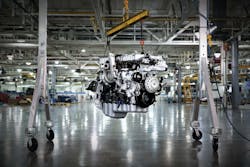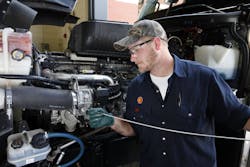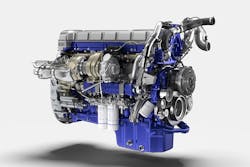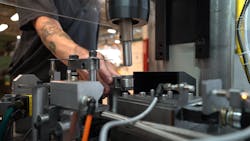Engine trends impacting performance and fuel efficiency
Manufacturers continue to introduce new technologies and products that will help fleets achieve a double-digit miles-per-gallon average in the not-too-distant future. While this goal seems more attainable for the long-haul segment, companies have made continual strides to help make engines more fuel efficient with better performance across numerous industry segments.
While improving fuel economy certainly addresses environmental concerns and government regulations, better fuel efficiency also makes good business sense – because the less fuel used, the more money a fleet will save.
“Fuel economy goes hand-in-hand with emissions,” says Dan Arcy, global OEM technical manager for global lubricant supplier Shell Lubricants. “If we reduce the amount of fuel that’s consumed, we reduce the amount of emissions that come out of the stack.”
Emissions from diesel engines consists of nitrogen oxide (NOx), hydrocarbons, carbon monoxide, and particulate matter (PM), which is sometimes referred to as soot.
Addressing the need to reduce emissions, without sacrificing engine power, has attributed to a number of performance and design improvements made to engines and their related components in recent years.
“The experience of 2010 has taught the industry to pay a lot of attention when introducing new technology to the potential maintenance issues downstream,” says Dr. Mihai Dorobantu, director of technology planning and government affairs, Eaton Vehicle Group. “The transportation sector has a very long memory of what happened in 2007 and 2010 with new trucks on the side of the road, and nobody has any appetite for that happening again.”
Eaton Vehicle Group provides products designed to improve vehicle efficiency, such as emission control components, engine valves, and valvetrain systems, as well as driveline expertise through transmission, clutch, and torque management systems.
As with any newly introduced technologies, a jump in maintenance is not necessarily welcomed but always expected. “Maintenance starts to get reduced after the initial bump in issues, which will happen whenever you’re introducing new technologies,” says Dr. Dorobantu. “As the technology matures, we’re in a much better maintenance position now than we were 10 years ago.”
Achievements and byproducts of new powertrain technology
A significant change in engine design and operation occurred more than a decade ago, when engine manufacturers were tasked with creating powertrains that could still perform as needed for fleets, while adhering to the latest line of federal regulations dictating the allowable emissions for heavy duty on-highway vehicles. Addressing these regulation requirements required an entirely new view of how the powertrain must operate.
Various changes that have been implemented on the engine and vehicle powertrain in the last two decades have each had an impact on the performance, the efficiency, and the service of the engine and the powertrain overall.
Advancements in fluid composition and usage, specifically diesel fuel and engine oil, can be attributed to the improvements made to the durability and mechanical design of the engine and powertrain components.
Significant changes to the powertrain stemmed from the design of an aftertreatment system that would collect the necessary emissions – specifically PM and NOx created by the engine – and ultimately, pave the way to a system design that would create less emissions in the first place.
Improved fuel injection processes
“Forty years ago, everything was all mechanical,” says Shell Lubricants’ Arcy. “Now you’ve got computer controls where you have fuel injected multiple times per ignition cycle.”
Compared to the previous mechanical method of injecting fuel only at the top of a piston stroke – which would lead to a rich mixture of fuel to air, and lead to wasted fuel – electronic controls allow fuel to be injected into the cylinder incrementally multiple times, and in many cases in varying amounts, during one piston stroke to improve the efficiency of it the engine. Delivering multiple injection events during the compression cycle provides the engine with the ability to fully combust the fuel with a leaner air-to-fuel mixture, while reducing emissions and improving fuel economy.
“Modern diesel engines such as the [International] A26 have a higher compression ratio than older engine technology,” says Jim Nachtman, heavy duty marketing manager for Navistar. Navistar manufacturers International brand trucks. “This, along with boost from [a] turbocharger and precisely timing fuel injection events, combine to increase the firing pressure in the engine, to maximize fuel efficiency.”
High-pressure common-rail (HPCR) systems are ubiquitous in nearly all late model on-highway diesel engines today. HPCR systems help to provide more precise delivery of fuel into the fuel injectors, at a much higher pressure and temperature than electronic unit injector systems.
“High-pressure common-rail fuel injection systems have been one of the key technologies for improving fuel efficiency in modern commercial vehicles,” explains C. G. (Lilo) Hurtado, applications engineer manager, North America commercial diesel, ExxonMobil Fuels and Lubricants. “The new fuel system has provided better spray characteristics and more precise control of fueling.”
ExxonMobil is an international oil and gas company serving multiple transportation sectors.
“Increased fuel injection pressure enables better mixing of the fuel with the air in the cylinder, resulting in better combustion and improved fuel economy,” adds Landon Sproull, vice president, Paccar. Paccar is the parent company for Peterbilt and Kenworth truck brands. “Some older high-pressure systems produced high fuel temperatures due to inefficient compression processes, but new engines put much less heat into the fuel. Return fuel temperatures are now optimized to maintain acceptable tank temperatures in the summer while preventing fuel gelling in the winter.”
A high-pressure fuel pump connected to the engine pumps fuel at high pressures to deliver the fuel to the fuel injectors at a steady rate. This immense amount of pressure, and the temperature, changes the composition of the diesel fuel from a liquid to a gas. This process is known as atomization. Atomization allows the diesel to form smaller droplets to ensure the fuel is more efficiently utilized during the injection process.
In addition to the injectors themselves, engine manufacturers have made improvements on other aspects of the system to help improve fuel efficiency, says Kris Ptasznik, X15 product manager for heavy duty engine manufacturer Cummins. “Injection spray plume and spray angle are optimized in conjunction with the piston bowl geometry and engine swirl to ensure proper combustion while controlling emissions and maximizing fuel economy.”
Brian Daniels, manager, Detroit powertrain and component product marketing for Daimler Trucks North America (DTNA) explains how the manufacturer’s proprietary Detroit DD15 engine utilizes a type of HPCR system to optimize fuel usage, which pressurizes the fuel at more than 30,000 psi.
DTNA is a heavy duty truck manufacturer, producing Freightliner, Western Star, and Thomas Built Buses nameplates.
“Higher temperatures have allowed us to simplify the engine and remove the fuel heating element, Daniels says. “Higher pressures have also brought on increases in robustness of the crankcase and block which helps improve overall engine reliability.”
HPCR systems communicate with the ECU and are monitored through numerous sensors and electronically controlled using solenoids and/or actuators to provide the accurate and intended amount of fuel to injectors.
HPCR systems and improvements to the injection process and components have dictated a need for a higher-performing diesel fuel. Depending on application, one challenge fleets may face is injector deposits.
“Newer more advanced additive formulations have been developed to target specific issues related to deposits and wear for newer engine and injector technologies to help keep them running at optimum performance,” says Jay Silvas, manager of product quality and technology for Citgo. Citgo refines, transports, and markets fuels, lubricants, and petrochemicals for the various transportation markets, including heavy duty trucks.
“As the fuel system is adapted for higher pressure, smaller nozzle holes, and a larger number of injections per cycle, the injection system becomes not only more expensive but also more sensitive to the deposits forming both inside the injectors and the nozzle holes,” Hurtado explains.
ExxonMobil introduced a pre-additized fuel to the market, the Synergy Diesel Efficient fuel product, to help address potential fuel deposit issues.
“Synergy Diesel Efficient also helps to prevent a loss in performance caused by internal injector deposits, which result in cold start problems due to sticking internal moving parts, and nozzle deposits, which can reduce power and responsiveness due to deteriorated spray quality. Premature injector failure has become a concern for many fleets due to associated service interruption and the high cost of replacing the injectors,” explains Hurtado. The pre-additized fuel is also designed to prevent premature fuel filter plugging with the use of biodiesels and provides additional fuel system corrosion protection, he adds.
Updates to diesel and best practices for fuel usage and dispensing
The industry has seen a shift over the last few decades with limiting the amount of sulfur in diesel fuels.
“You go back 20 to 30 years ago, diesel fuel had upward 3,000 to 5,000 ppm of sulfur in it,” Shell Lubricants’ Arcy explains. “Now on-highway diesels, as of late-2006, have a maximum 15 ppm. How this all works together is the emission systems on trucks today require fuel that has a lower sulfur content to work efficiently. All that has reduced the amount of emissions coming out of the exhaust pipe.”
The higher levels of sulfur would wreak havoc on the aftertreatment systems, says Arcy. It would also jeopardize the longevity of internal engine components due to the higher acid levels in higher sulfur diesel.
While ULSD has become commonplace for heavy duty trucks for more than a decade, it is important to note fleets should continue adhering to best practices when it comes to fuel storage, delivery, and fuel filtration.
“Draining the fuel water separator and regularly changing the fuel filters is required to prevent contaminants from entering the fuel system,” says Navistar’s Nachtman. “Purchasing fuel from a high-volume filling station can help ensure fuel is free from moisture or contaminants.”
Verifying the quality of fuel, preventing algae growth in tanks, and avoiding misuse of fuel additives also helps to ensure the optimized performance of diesel fuel, says Paccar’s Sproull.
Lower viscosity oils
“Engines run hotter than they did 30 years ago, so oils have had to change to withstand that higher heat and to protect the engines,” explains Shell Lubricants’ Arcy.
Federal emissions standards in 1998, 2004, 2007, and beyond dictated changes to the requirements of engine oil to be used in engines. This is because the combustion process changed, with an increased amount of PM, or soot, generated. The PM was then captured by oil.
As engine manufacturers worked through these design changes in order to meet federally mandated emissions reductions – specifically with designs that delayed injection timing and the introduction of exhaust gas recirculation (EGR) – more PM was generated during the combustion process and deposited into the crankcase, says Arcy.
“As we’ve changed and gone to things like selective catalytic reduction (SCR) to take care of NOx emissions, they’ve been able to advance injection timing and run some lower EGR rates,” Arcy explains. “As a result of those things happening, instead of taking care [of] NOx in the cylinder, [the system takes] care of it in the exhaust pipe. So, soot levels have been reduced dramatically.”
Now that engine oil formulas have been adjusted to withstand higher temperatures, and less PM is trapped in engine oils, oil companies are looking to additional changes to engine oil composition to further improve system efficiencies. One of those is continual advancements in creating lower viscosity engine oils. Lower viscosity oils inherently improve efficiency because less work is required to move the oil through the system, which translates to less internal resistance.
In December of 2016, to address changes in the requirements of heavy duty engine oils, the American Petroleum Institute (API) released its latest round of oil grade specifications — FA-4 and CK-4 — as a follow-up to the CJ-4 engine oil standards.
“Newer engines run at higher temperatures, where conventional lubricants can be stressed, and the rate of oxidization and degradation is accelerated,” says Ron LeBlanc Sr., senior technical advisor for lubricant and grease developer Petro-Canada Lubricants. “The latest engine oils are more resistant to oxidation, they have increased shear stability, and have lower viscosity – specifically the FA-4 category – which leads to lower engine oil flow resistance in the engine and a reduction in fuel consumption, while still offering increased levels of wear protection.”
Engine oils meeting the CK-4 engine oil specification are backward compatible with CJ-4 engine oils. FA-4 engine oils have lower viscosity grades to meet the needs of next-generation diesel engines. FA-4 engine oils should only be used if directly specified by the engine manufacturer.
“A frequently asked question is ‘What is the advantage of an API FA-4 10W-30 engine oil compared to an API CK-4 10W-30 engine oil?’” says Mark Betner, manager of lubricant national account sales, Citgo. “A basic explanation is that when comparing the CK-4 10W-30 with an FA-4 SAE 10W-30 engine oil, the FA-4 10W-30 oil will provide increased fuel efficiency. Modern engines tend to create greater stress on the oil due to higher contact gearing, which requires increased viscosity stability and retention; and some modern diesel engines tend to cause greater oil aeration, which requires greater air release properties from the engine oils.”
API FA-4 and CK-4 engine oil specifications are designed to provide better oxidation resistance, shear stability, and aeration control compared to CJ-4 engine oils, and improved high-temperature/high-shear (HTHS) viscosity, according to Paul Cigala, CVL applications engineer, ExxonMobil Fuels and Lubricants. “Specifically, FA-4 oils offer lower HTHS viscosity than other oil categories, enhancing fuel economy potential and saving fleets on fuel costs,” he says.
“A movement to lighter viscosity – like 5W-30, 10W-30, and specifically API FA-4 quality type oils that are at the lower end of those viscosity grades – provide[s] this reduced energy required to pump the [engine oil] through the engine, while being designed with the correct additives necessary to help provide wear protection,” says Arcy.
Viscosity grade does not dictate the oil change interval, Arcy adds. This is dependent on vehicle application, using a general miles-per-gallon formula to estimate the determined oil change interval. Additional considerations are total idle time, the number of engine hours operated, and engine size. It is important to note that a thorough oil analysis program is integral to ensuring the optimized life of an engine oil.
“Modern diesel engines operate with reduced idle time and have significantly reduced oil consumption even with increased oil change intervals,” Betner says. “Engine oil change intervals have also changed significantly over time which, depending on the severity of operation and fuel consumption, some engine manufacturers recommend oil change intervals out as far as 75,000 miles in some applications and operations. That’s three times around the earth at the equator without an oil change.”
Arcy also notes that heavy duty vehicles manufactured from 2013 and on may also benefit from specifying a lower viscosity engine oil than what’s currently used. For instance, specifying an SAE 10W-30 engine oil viscosity grade, compared to the traditional 15W-40 viscosity grade many fleets use today.
It is important to note, fleets should adhere to both the engine manufacturers recommended oil change interval and oil viscosity recommendation. Fleets interested in exploring extended oil drain intervals or a lower viscosity oil should work with their engine manufacturer directly.
Additionally, the shift to synthetic blends and full synthetic engine oils has helped with engine operation in more extreme conditions.
“The synthetic [engine oils] can handle higher temperatures and will not break down as rapidly. The additives will not be consumed as quickly,” explains Arcy. “They (synthetics) also will be in the lower viscosity ranges, allowing for improvements in cold-temperature flow and startup.”
LeBlanc Sr. warns against changing the composition of the engine oils as well and the use of additional additives not already included in the original oil’s composition.
“Oil additives already make up between 10 and 20 percent of a heavy duty lubricant that has been validated to OEM-approved standards,” LeBlanc Sr. says. “The additive system is comprised of a careful balance of additives that work together to ensure hardware protection and longevity of vital components.”
Engine downsizing
A trend in engine downsizing, which refers to a lower displacement volume, can provide fuel economy benefits because a smaller engine would inherently use less fuel. For example, specifying a 13L engine compared to a 15L engine. Coupled with that, a smaller engine unit means less material used during the production of that system. OEs, like Navistar, have looked to still provide the same amount of horsepower with the smaller engines.
“Engine downsizing provides benefits, over 600 pounds in weight savings for the [International] A26,” Nachtman explains. The proprietary International A26 12.4L engine provides 365 to 500 hp, and 1,250 to 1,750 ft-lb of torque. “This contributes to fuel economy improvements, as well as higher payload capability in some applications. Smaller engines tend to be easier to service as well.”
For those fleets opting to operate the same sized engines, newer designs offer more horsepower than previous generations.
“A lot of those engines – 30 years ago – may have been similar in size [as to what they are today] with 350 hp maybe 400 hp, in that range. Now 15L engines [provide up to] 600 hp,” advises Shell Lubricants’ Arcy. “You’re taking the same displacement engine, and you’re getting over 30 percent more horsepower, and improving fuel economy, and reducing emissions.”
A number of manufacturers have taken an opposite approach to this trend, keeping the engine displacement volume the same, translating to even more horsepower and torque. Daimler’s Daniels explains the Detroit DD15 15L engine has been a popular size for long-haul applications, while the Detroit DD13 13L engine has been more commonly specified for regional and vocational applications.
“Selecting the right power rating is also important,” says Daniels. “Higher displacements and horsepower ratings are making it easier for fleets to keep drivers satisfied with the performance of the vehicle; and for fleets that prefer the most efficient setup, lower the horsepower and rear axle ratios (to) get the most distance out of the fuel in the tank.”
Of course, it is important to consider the duty cycle and application whenever specifying engines.
Overall, efficiencies have improved, and downsizing may be a suitable option for some fleets.
Downspeeding
In recent years, engine manufacturers have continued to push the minimal engine operating rpm, without compromising torque, from 1,500 rpm down to 1,200 rpm, and even lower.
“Downspeeding allows the engine to make the required horsepower at a lower engine rpm,” explains Navistar’s Nachtman. “Thus, reducing internal engine friction [and] improving fuel efficiency.”
Downspeeding may allow for lower rates of fuel consumption, but specifications with the transmission and rear axle ratio configurations must be considered in order to benefit from this functionality. This is another reason the industry has seen a continued shift toward automated manual transmissions, according to Eaton’s Dr. Dorobantu.
“Cruise points went down from 1,400 rpm to 1,100 rpm,” Dr. Dorobantu explains. “That is significant downsizing of the engine, and that has implications of lower friction. You need to make the engine more robust; automation protects the driveline better against misuse and increases the safety.”
Turbo compounding
While turbo compounding has traditionally been seen as a means to increase engine performance, it can also help to improve fuel efficiency.
Turbo compounding is a waste heat recovery method designed to recirculate the exhaust gases back into the system through the use of a power turbine. This recirculation of gases can provide an additional boost of power to the engine, while also limiting the exhaust emitted from the vehicle.
“The turbo compound engine is designed to create more power with less energy,” explains John Moore, product marketing manager, commercial vehicle OEM Volvo Trucks North America (VTNA).
VTNA manufactures Volvo Trucks and Mack Trucks. Both brands can be specified with Volvo engines, mated with the company’s proprietary I-Shift transmission.
Turbos are another system added to the vehicle, so they inherently make the system more complex. Manufacturers have taken strides to help simplify the system and make improvements.
Historically, the drawbacks of a turbo compound engine would be that more fuel is used for the turbo compounding process – but improved precision with the fuel injection process, as mentioned earlier, has helped to limit the use of fuel. Add to that, advancements in system software have helped to better optimize the use of the turbo compounding functionality.
Volvo recently introduced its second generation of turbo compounding engine, the D13TC, to provide additional fuel efficiency benefits. The newest iteration provides greater PM reduction and an increased compression ratio to improve fuel efficiency, says Moore. “Less soot from the cylinder increases exhaust gas recirculation and exhaust aftertreatment system reliability,” he adds.
“In order to truly maximize fuel efficiency, Volvo Trucks recommends pairing the D13TC engine with the appropriate [drivetrain] for the specific application,” Moore adds. “Aerodynamic features can also have a considerable impact on the overall efficiency of the truck. Additionally, a maximum trailer gap should be set close to 44 inches for best fuel efficiency.”
Engine turbochargers also have a direct impact on the performance of the engine braking system.
“Engine power can be increased through a variety of methods,” says Navistar’s Nachtman. “Higher boost from the turbocharger puts more air into the engine, allowing the engine brake to make more brake horsepower.”
Engine braking improvements
Jacobs Vehicle Systems’ Director of Technology, Robb Janak, explains that in its most basic sense, a compression release engine brake helps to improve fuel efficiency simply by reducing the total drive time. This is because an engine brake can allow for a higher maximum controlled speed downhill.
Jacobs Vehicle Systems designs engine retarding systems and valve actuation mechanisms, as well as provides engine brakes and emissions solutions to medium and heavy-duty engine makers.
More commonly known as an engine brake, the system works by opening the exhaust valves after a compression stroke to release the compressed gas in the cylinders. This, in turn, slows the vehicle.
Updates to engines have also impacted the design of the traditional engine brake.
“The engine architecture completely changed,” he explains, of the evolution of the engine braking system becoming integrated into the valve train. “We went from an add-on the overhead, to an integrated element within the valve train in the past 10 to 20 years.”
While not a direct impact on the powertrain system, engine brakes do help to extend the life of traditional air brakes. “The biggest wear you can put on service brakes is when you’re using them for any long duration, or anything really besides a short burst. It (otherwise) raises the temperature dramatically and wears the brake pads over time,” says Janak. An engine brake does not require the use of service brakes to operate. When using an engine brake, “you still have full use of your service brakes if you need to do an emergency stop,” he adds.
Integration considerations
Proper specifications are integral to the optimized performance of a vehicle’s engine. This requires a holistic approach that takes into consideration the entire powertrain – not only the engine but also the transmission and axle ratios.
Other areas of the powertrain that have directly impacted the operation of the engine include automation of different vehicle systems, such as the transmission, and a shift to higher usage of electronic parts within these systems.
Case in point, Eaton’s Dr. Dorobantu notes that in less than a decade, the industry has seen a significant shift in the change from manual to automated manual transmissions (AMTs), with a 5 percent adoption rate less than a decade ago to 70 percent today.
“Automation allows the shift to be done effortlessly – the driver doesn’t have to care about it – and that then allows the powertrain to shift much more often to handle small grades at low engine speeds and lower power,” he says. “From that perspective, that has been a fuel efficiency play partially driven by regulations but mostly driven by the need for long-haul fleets to reduce fuel consumption.”
Advancements like this have been made possible with the continued advancements in vehicle computer systems and electronic components. When a system no longer relies on human interaction, it can better optimize the operation of the system, and improve the integration of multiple systems together.
“Balancing the optimal engine speed with the optimal shift patterns and gear ratios of the transmission is where integration can significantly improve fuel efficiency,” Navistar’s Nachtman says.
Companies have also begun to integrate surrounding environmental changes to improve the functionality of these powertrains. “We also enable fuel efficiency gains using electronic powertrain features like SmartCoast and Predictive Road Speed Governor,” says Cummins’ Ptasznik. “These use what we know about how the truck is running and the customer’s operating conditions to make sure trucks are the right gear, or coasting at the right speed, to run most efficiently.”
Additionally, consider aerodynamic options, such as improved sloped tops on the cab, extended side fairings, and side chassis fairings for less wind resistance, wheel covers, and trailer skirts, and tightening the gap between the tractor and trailer. Beyond that, lower rolling resistance tires can also reduce drag and improve fuel efficiency.
While service and maintenance are critical parts of the maximized uptime of a vehicle’s powertrain, taking a holistic approach by involving all departments will have a profound impact on improved fuel efficiency. Review current processes to confirm where changes can be made to existing PMs and service, and work to understand future technologies to ensure the best specification for the application while also achieving the best fuel economy.
Driver training is also a critical part of the optimized fuel economy of the vehicle.
To put this in perspective: “Beyond service, one of the most significant factors in fuel efficiency is the vehicle’s cruising speed; for every 1 mile-per-hour over 55 [mph], fuel economy is reduced by about 0.1 miles-per-gallon,” says Paccar’s Sproull.
“It’s important for fleets to evaluate all contributing factors to improve fuel economy and make productivity gains, including driver style, tire pressure, idle time, truck design, and more proactive measures that could be incorporated into a wider maintenance program,” adds Petro Canada Lubricants’ LeBlanc Sr. “Finding fuel efficiency gains in any of these areas can have a significant impact on a company’s bottom line and make a real difference to its productivity.”
“It will take more than one new technology to meet future targets, but there is an industry-wide push to increase fuel efficiency from the powertrain, chassis, and cab along with the trailer,” says VTNA’s Moore. “That will involve improvements such as [higher gear] ratios, more downspeeding, idle reduction technology, improved aerodynamics between tractor and trailer, enhanced 6-by-2 (axle) technology, lighter-weight components, and low rolling-resistance tires that meet demands for traction and longevity.”
Conclusion
“The trucking industry has done a great job of evolving over the years,” says Shell Lubricants’ Arcy. “If we go back 30 years ago, it wasn’t uncommon to see a black plume of smoke from a truck. Now you see nothing. We’re putting out less emissions, our engines are lasting longer, and we’re getting better fuel economy. That’s win-win-win.”
Incremental advancements, and new system functionalities and improvements have brought the industry to where it is now and will continue to push the development of new technologies moving forward. Change does not happen all at once.
“Initially there will be many small changes to improve friction, air management, and combustion efficiency,” suggests Paccar’s Sproull. “Advanced controls and even deeper powertrain integration will also provide benefits. Further out, increased electrification of major engine systems, advanced turbocharging concepts, and faster combustion are other technologies OE’s may turn to [in order to] deliver increased performance and economy.”
Powertrain items to consider for PM checklists
When it comes to the engine, there are a number of areas, systems, and components to periodically check in order to ensure maximized vehicle uptime.
It is critical to adhere to both the proper intervals, and to review all necessary aspects of the engine, to ensure vehicle uptime is maximized by a fleet.
Many engine OEs provide general guidelines dependent on application including severe duty, short-haul, and long-haul. A general rule of thumb is to assess based on the miles-per-gallon average of the fleet.
An owner’s manual, or assistance from the engine manufacturer, is the best way to ensure all areas of the system are in the best working order.
Items to consider when reviewing preventive maintenance checklists include: oil drain intervals, engine oil filters, engine oil levels, fuel filters, coolant filters, coolant levels, drain water separators, engine lash adjustments, electrical system components and harnesses, assess belts, piping, and clamps, diesel exhaust fluid (DEF) filters, and diesel particulate filter (DPF) ash cleaning intervals or filter replacement.
About the Author
Erica Schueller
Media Relations Manager | Navistar
Erica Schueller is the Media Relations Manager for Navistar.
Before joining Navistar, Schueller served as Editorial Director of the Endeavor Commercial Vehicle Group. The commercial vehicle group includes the following brands: American Trucker, Bulk Transporter, Fleet Maintenance, FleetOwner, Refrigerated Transporter, and Trailer/Body Builders brands.
An award-winning journalist, Schueller has reported and written about the vehicle maintenance and repair industry her entire career. She has received accolades for her reporting and editing in the commercial and automotive vehicle fields by the Truck Writers of North America (TWNA), the International Automotive Media Competition (IAMC), the Folio: Eddie & Ozzie Awards and the American Society of Business Publication Editors (ASBPE) Azbee Awards.
Schueller has received recognition among her publishing industry peers as a recipient of the 2014 Folio Top Women in Media Rising Stars award, acknowledging her accomplishments of digital content management and assistance with improving the print and digital products in the Vehicle Repair Group. She was also named one Women in Trucking’s 2018 Top Women in Transportation to Watch.
She is an active member of a number of industry groups, including the American Trucking Associations' (ATA) Technology & Maintenance Council (TMC), the Auto Care Association's Young Auto Care Networking Group, GenNext, and Women in Trucking.
In December 2018, Schueller graduated at the top of her class from the Waukesha County Technical College's 10-week professional truck driving program, earning her Class A commercial driver's license (CDL).
She has worked in the vehicle repair and maintenance industry since 2008.





